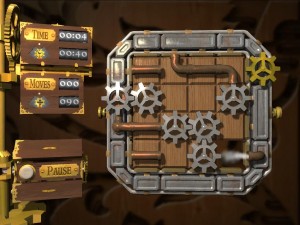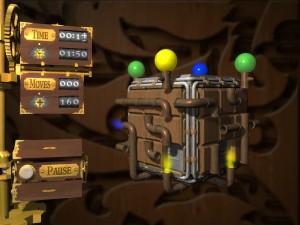Cogs
 Cogs is essentially a series of sliding-block puzzles of the sort that have bored puzzle-gamers for over a hundred years (ever since the “fifteen puzzle” craze of 1880 died down), except that instead of putting together a picture, you’re putting together a machine. There are tiles with gears on them, capable of transmitting motion, and tiles with segments of piping, capable of transmitting steam. Some levels have the one, some have the other, and a few have both.
Cogs is essentially a series of sliding-block puzzles of the sort that have bored puzzle-gamers for over a hundred years (ever since the “fifteen puzzle” craze of 1880 died down), except that instead of putting together a picture, you’re putting together a machine. There are tiles with gears on them, capable of transmitting motion, and tiles with segments of piping, capable of transmitting steam. Some levels have the one, some have the other, and a few have both.
Gears are basically simpler than pipes, because you don’t have to worry about orientation or leakage (some pipes branch), but there are levels that complicate things by putting gears at different heights on a single shaft. In fact, some of the tiles (both gear and pipe) are two-sided, so you have to flip the board around to coordinate the needs of two different sub-systems. This takes advantage of something that sliding-block puzzles based on pictures or ordering numbers generally don’t have: the interchangeability of identical parts. The game doesn’t ask you to put particular pieces in particular places. It just asks you to put together something that works, and if a piece has more than one purpose, it’s possible for it to work for one purpose and not the other.
Actually, sometimes a specific piece does need to be in a specific place. For example, if you have exactly one pipe bend, and have to connect an inlet and an outlet that are perpendicular to each other, you have to put that bend at the place where straight lines from the inlet and outlet intersect. But in such cases, the exact placement of the tile isn’t one of the puzzle’s constraints, but rather, something derived from those constraints. The first step in any puzzle here is figuring out what the derived constraints are — not “How do I get the tiles where I need them?”, but “Where do I need the tiles?” The act of getting them there is a relatively trivial matter for the experienced puzzler, and exists mainly to take up time and build up anticipation, like all the walking around in a typical adventure or RPG.
Being able to enact your designs quickly and efficiently is rewarded, however. Each puzzle you solve rates you on time and number of moves taken, and gives you a number of “stars” on that basis. Stars contribute towards unlocking more puzzles, or, once all 50 puzzles are unlocked, go towards certain Achievements. Also, there are two “challenge” modes that put hard constraints on the time spent or moves taken. To me, move challenges are an interesting extension of the puzzle, and I may well spend some time on them, but time challenges don’t interest me at all. Since there’s no randomization in this game, the obvious way to pass a time challenge is to simply memorize a solution, and that’s not how I want to play a puzzle game. Even going through the puzzles in non-challenge mode, I usually maxed out the stars for moves but not for time.
 I haven’t mentioned the game’s most obvious feature from screenshots and videos: the three-dimensionality, the fact that some puzzles are on multiple sides of objects that you can rotate freely. That’s because it’s not all that important. The 3D puzzles are pretty, but the tiles are still bound to specific faces; there are linkages that transmit rotary motion from face to face, but you can’t move them. So all the 3D does is chop the puzzle up into smaller and easier sub-puzzles. There’s one puzzle that looks at first like it’s a single tile-grid spread over the surface of a cylinder, but in fact there’s a vertical seam, so it’s really just a rectangle that you can’t see all at once. I suppose the UI isn’t set up to support actual loops — you can push multiple tiles in a line at once, so if a puzzle were truly cylindrical, there would be ambiguity when you clicked on a tile about which direction you wanted to push it.
I haven’t mentioned the game’s most obvious feature from screenshots and videos: the three-dimensionality, the fact that some puzzles are on multiple sides of objects that you can rotate freely. That’s because it’s not all that important. The 3D puzzles are pretty, but the tiles are still bound to specific faces; there are linkages that transmit rotary motion from face to face, but you can’t move them. So all the 3D does is chop the puzzle up into smaller and easier sub-puzzles. There’s one puzzle that looks at first like it’s a single tile-grid spread over the surface of a cylinder, but in fact there’s a vertical seam, so it’s really just a rectangle that you can’t see all at once. I suppose the UI isn’t set up to support actual loops — you can push multiple tiles in a line at once, so if a puzzle were truly cylindrical, there would be ambiguity when you clicked on a tile about which direction you wanted to push it.
It’s possible that I’m not the target audience here. There are two puzzles that really are just traditional picture-assembly (with the excuse that you’re piecing together large gears composed of more than one tile), and the first and easier of the two warns you that it will involve extra planning ahead, as if you’re not familiar with this sort of thing. Likewise, there’s the length: solving all 50 puzzles took me less than four hours, and I expect it’ll be similar for most experienced puzzlers, provided they don’t give up.
Still, this is a game worth looking at for what it does: it takes a tired puzzle-type and comes up with ways to make it interesting again. I wonder if anyone’s tried something similar with the Towers of Hanoi? I suppose that’s kind of what The Bryant Collection does, but only in a sort of proof-of-concept way.
 Comments(4)
Comments(4)
Professor Layton games have both sliding puzzles, and Towers of Hanoi puzzles (and loads of other, different types) wrapped up in an adventure game framework.
All three currently released are worth checking, if you’re into that sort of thing.
Okay, but do they do anything new with the concepts, or do they just embed the familiar versions in a larger context?
I don’t recall seeing anything new, puzzle design wise there. I guess only DROD can deliver that.
But it’s wrapped in a very attractive package, which helps with motivating to solve even the most tedious problems (I hate hate hate sliding puzzles).
I think the thing to do with the Tower of Hanoi is to think more about the backstory: Why does the world end when the tower is finished?
What I figure is, it’s a gigantic spaceship. The disks are parts of the engine which get charged up on the first tower and put in place on the third (the second is a staging area). And the people that designed it realized civilization was about to collapse on the surface, so they put most of the ship underground, in stasis, and made sure that the people up above had a very powerful legend about moving the tower that would keep them going through the generations that it took to actually finish the thing (I’m assuming that the collapse of civilization forced them to use a much slower method of finishing everything by hand.)
Of course most of the game wouldn’t involve actually moving the tower, which would remain tedious beyond belief, though their might be some bits at the beginning where the PC (or one of them, since the game spans generations) learns to do a little Tower of Hanoi, which is one of the most important rituals they have. I sort of imagine a nice fight scene on top of a Tower where the discs are being moved as they fight.